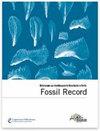Mid-Cretaceous沿海琥珀林古环境揭示了一个现存谱系中保存完好的介形类
IF 2.1
4区 地球科学
Q1 PALEONTOLOGY
引用次数: 2
摘要
作为著名的Lagerstätte化石,来自缅甸北部克钦的白垩纪中期(约100 Ma)琥珀是迄今为止发现的最具多样性的中生代古生物群之一。在过去的几年里,关于克钦琥珀中被困生物的报道呈指数级增长。到目前为止,在克钦琥珀中,介形虫作为完全水生动物,有两个没有柔软部分的标本记录(1个瓣和两个甲),以及一个保存完好的柔软部分的特殊组合,包括属于Candonidae和Loxocancidae三个物种的39个标本。由于上一篇文章只关注一个物种的巨大精子和生殖器官的特殊保存,我们在这里对所有三个物种进行了深入的形态学描述,包括一个新属:Myanmarcypris hui Wang et al.,2020,Electrocypria burmiteigen。et sp.nov.和Sanyuania sp.。我们进一步描述了直翅目特征,表明所研究的介形虫很快被树脂包围并立即固定。古环境被认为是一个植被茂盛的半咸水(中盐-少盐)泻湖。本文章由计算机程序翻译,如有差异,请以英文原文为准。
Mid-Cretaceous coastal amber forest palaeoenvironment revealed by exceptionally preserved ostracods from an extant lineage
As a famous fossil Lagerstätte, the mid-Cretaceous (ca. 100 Ma) amber from Kachin, northern Myanmar, harbors one of the most diverse Mesozoic palaeobiotas yet discovered. Over the past few years, reports of organisms trapped in Kachin amber have increased exponentially. Ostracods, as fully aquatic animals, are so far represented in Kachin amber by two records of specimens without soft parts (1 valve and two carapaces) as well as an exceptional assemblage with well-preserved soft parts comprising 39 specimens of three species assigned to the families Candonidae and Loxoconchidae. Since the last-mentioned focused on the exceptional preservation of giant sperm and reproductive organs in only one species, we here present in-depth morphological descriptions of all three species including a new genus: Myanmarcypris hui Wang et al., 2020, Electrocypria burmiteigen. et sp. nov., and Sanyuania sp. We further describe taphonomic traits indicating that the studied ostracods were quickly surrounded by resin and instantly immobilized. The palaeoenvironment is considered to be a vegetated brackish (mesohaline-oligohaline) lagoon.
求助全文
通过发布文献求助,成功后即可免费获取论文全文。
去求助
来源期刊

Fossil Record
PALEONTOLOGY-
CiteScore
3.60
自引率
7.10%
发文量
18
审稿时长
14 weeks
期刊介绍:
Fossil Record (FR) is the palaeontological journal of the Museum für Naturkunde Berlin. This journal was founded in 1998 under the name Mitteilungen aus dem Museum für Naturkunde Berlin, Geowissenschaftliche Reihe and appears with two issues each year. Fossil Record publishes original papers in all areas of palaeontology including the taxonomy and systematics of fossil organisms, biostratigraphy, palaeoecology, and evolution. All taxonomic groups are treated, including invertebrates, microfossils, plants, and vertebrates.
 求助内容:
求助内容: 应助结果提醒方式:
应助结果提醒方式:


